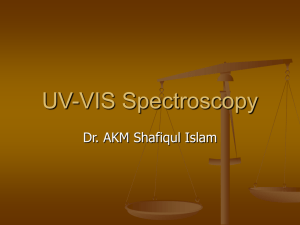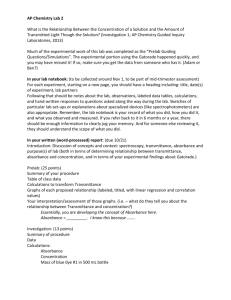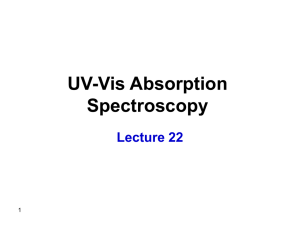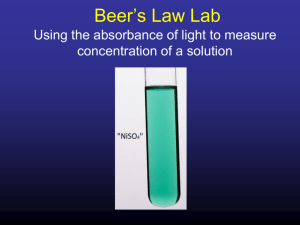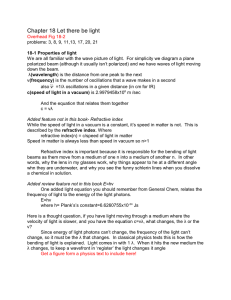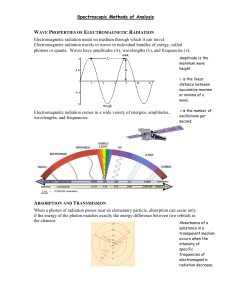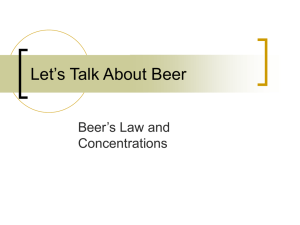Chapter 13 An Introduction to Ultraviolet/Visible Molecular Absorption Spectrometry
advertisement
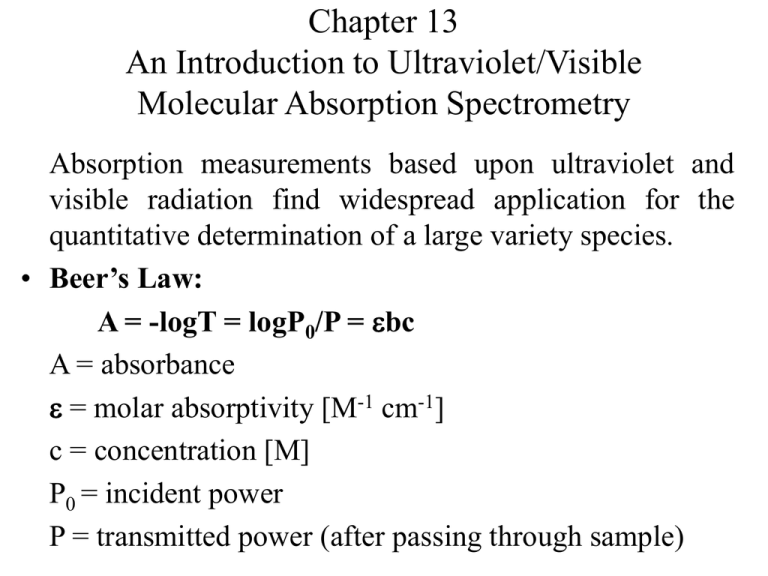
Chapter 13 An Introduction to Ultraviolet/Visible Molecular Absorption Spectrometry Absorption measurements based upon ultraviolet and visible radiation find widespread application for the quantitative determination of a large variety species. • Beer’s Law: A = -logT = logP0/P = bc A = absorbance = molar absorptivity [M-1 cm-1] c = concentration [M] P0 = incident power P = transmitted power (after passing through sample) • Measurement of Transmittance and Absorbance: The power of the beam transmitted by the analyte solution is usually compared with the power of the beam transmitted by an identical cell containing only solvent. An experimental transmittance and absorbance are then obtained with the equations. Psolution P T Psolvent P 0 P0 and P refers to the power of radiation after it has passed through the solvent and the analyte. Psolvent P0 A log log Psolution P • Derivation of Beer’s Law: Sample cell with absorbing molecules P0 P b=0 b=b db P P-dP dP P Incremental power lost power in; i.e., increase power in, increase power absorbed dP db Longer pathlength, greater number of molecules in incremental slice and more power absorbed Therefore, dP Pdb dP = -kPdb k = proportionality constant (function of , c) negative sign: because power is lost (i.e., absorbed) Rearrange: dP kdb P Integrate: P b 1 P 0 PdP k 0 db InP InP0 kb ( k )(0) P In kb P0 Factor out concentration part of k: k = k”c P In k " bc P0 Convert fraction (remove –sign) and change In to log: (1/2.303)k” = P0 1 log k :" bc P 2.303 P0 A log bc P • Application of Beer’s Law to Mixtures Beer’s law applies to a medium containing more than one kind of absorbing substance. Provided there is no interaction among the various species, the total absorbance for a multicomponent system is given by Atotal = A1 + A2 + … + An =1bc1 + 2bc2 + … + nbcn where, the subscripts components 1, 2, …, n. refer to absorbing Assumptions in derivation of Beer’s Law • Monochromatic incident radiation (all molecules absorb light of one ) • Absorbers independent (Absorbing molecules act independently of one another i.e, low c) • Pathlength is uniform (all rays travel the same distance in sample) • No scattering • Absorbing medium is optically homogeneous • Incident beam is not large enough to cause saturation • All rays should be parallel to each other and perpendicular to surface of medium. Limitations (deviations) of Beer’s Law • High concentration (close proximity of molecules affects absorption) • Analyte dissociation to product with different absorption characteristics (e.g., pH-dependent indicators) • Polychromatic radiation (i.e., light of more than one ) p' P"0 Ameas log P' P" 0 Where P’ and P” are powers for ’ and ”, respectively – Negative deviation = lower absorbance than predicted because higher transmittance – Higher T because molecules don’t absorb one as well as other • Stray radiation p' Ps A' log P' Ps 0 Ps = power from stray radiation Extra light hits detector higher T; lower A Instrumentation • • • • • • Light source - selection Sample container Detector Signal processing Light Sources (commercial instruments) – D2 lamp (UV: 160 – 375 nm) – W lamp (vis: 350 – 2500 nm) • - selection (monochromators) • Sample holders – Cuvettes (b = 1 cm typically) – Glass (Vis) – Fused silica (UV 350 nm) • Detectors – Photodiodes – PMTs • Single beam – Place cuvette with blank (i.e., solvent) in instrument and take a reading 100% T – Replace cuvette with sample and take reading % T for analyte (from which absorbance is calc’d) • Double beam (most commercial instruments) – Light is split and directed towards both reference cell (blank) and sample cell – Two detectors; electronics measure ratio (i.e., measure/calculate absorbance) – Advantages: • Compensates for fluctuations in source and drift in detector • Better design for continuous recording of spectra • • • • • Multichannel Instruments Photodiode array detectors used (multichannel detector, can measure all wavelengths dispersed by grating simultaneously). Advantage: scan spectrum very quickly “snapshot” < 1 sec. Powerful tool for studies of transient intermediates in moderately fast reactions. Useful for kinetic studies. Useful for qualitative and quantitative determination of the components exiting from a liquid chromatographic column.

